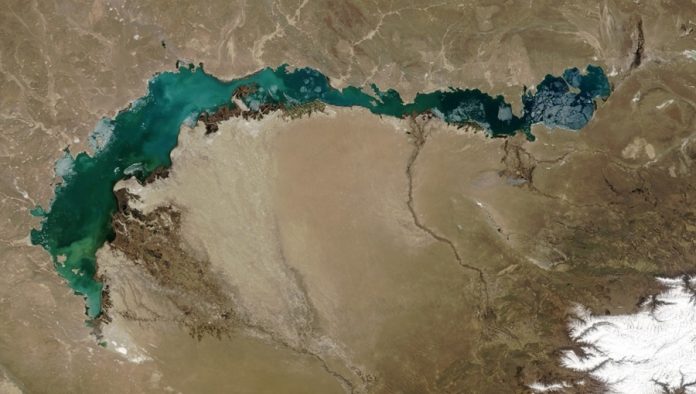By Seymur Mammadov (Baku)
The Kyrgyz have a saying: “El bashi bolboy, suu bashi bol“, which translates to: “Do not be the head of the people, but be at the source, the head of the water.”
This old proverb remains extremely relevant today. Water is life. This simple truth is universally acknowledged and needs no proof. Those who control water sources control everything. The availability of abundant water resources contributes to the socio-economic development and well-being of people. Water is a strategic resource for which bloody wars were once fought. Today these issues are regulated by international law, but problems persist. With climate change, the issue of water resource scarcity is becoming increasingly pressing.
In the last century, the lack of fresh drinking water became a global problem, affecting over 40% of the world’s population.
A river runs through it
Azerbaijan also faces the problem of water shortage, despite having its own natural water bodies. The country has nearly 8,500 rivers, 24 of which are large, and 450 lakes. This is quite a lot, but according to experts, due to climate change, the water resources of the republic are decreasing every year. This process is happening worldwide, and each country is looking for its own solutions. For Azerbaijan, the situation is complicated by the fact that more than 70% of its water reserves are formed outside the country. The main rivers of Azerbaijan originate in neighbouring countries.
For comparison, in Kazakhstan, 7 out of 8 main river basins are transboundary. More than 40% of the annual renewable surface water resources come from neighbouring countries. Thus water imports in Kazakhstan are significantly lower than in Azerbaijan. Nevertheless, the problem of water shortage in Kazakhstan, as in all of Central Asia, is very acute.
As for Azerbaijan, after the Second Karabakh War the country’s water balance significantly improved. The water resources of sources in Karabakh and Eastern Zangezur account for 25% of the country’s total water resources. Most importantly, almost all rivers in the liberated regions originate within Azerbaijan itself, which is very important from a water security perspective.
Kazakhstan, on the other hand, is a “water-dependent” country: only 2.8% of its territory is covered with water. According to forecasts, by 2030 the volume of fresh water in the country could decrease five fold. To reduce dependence on water imports, Kazakhstan began the construction of 9 new reservoirs in 2023. In the future, their number should be increased to 20.
Wasting water
According to the latest study by the Eurasian Development Bank (EDB), “Drinking Water Supply and Sanitation in Central Asia,” 10mn people in Central Asia (14% of the population) do not have access to safe drinking water. Bank experts calculated that from 1994 to 2020 the volume of water intake for domestic needs in Central Asian countries doubled, while investments in drinking water supply infrastructure did not match the growth in consumption. As a result, there is almost 80% wear and tear on water supply and treatment infrastructure, and water losses in distribution networks have reached 55%.
Solving these problems requires funding. According to World Bank forecasts, by 2050, amid the projected demographic growth in Central Asia to 90mn people, a water deficit of 25-30% is anticipated. Agricultural water needs are projected to increase by 30% by 2030.
Despite the discouraging figures, most experts agree that the problem lies not in the shortage of water resources but in their inefficient use. According to the Food and Agriculture Organization (FAO), water resources in Central Asian countries are sufficient per capita (about 2,300,000 cubic metres). It is also noted that Central Asian countries are among the top ten water consumers in the world: Turkmenistan (5,319 cubic metres per year), Kazakhstan (2,345 cubic metres per year), Uzbekistan (2,295 cubic metres per year), Kyrgyzstan (1,989 cubic metres per year) and Tajikistan (1,895 cubic metres per year).
It has been established that in these countries, 2.5-3 times more water is used to produce a unit of agricultural product than in developed countries. In Tajikistan, 92% of the water consumed is used for agriculture with irrigated farming and in energy production, while only 4% is left for industry and utilities. Nearly 60% of the population does not have access to centralised water supply, and about 30% of the water supply networks in the republic do not function for various reasons.
In Kyrgyzstan water losses amount to 30 to 50% due to old water channels. Overall, the old ditch irrigation systems in the region’s countries no longer meet modern requirements, allowing only 40% of the water to be used, while the remaining 60% seeps into the ground or evaporates. This is a significant problem, considering that by 2050 the population of the region will reach 100mn people.
The problem of water import dependence is not only an issue for Kazakhstan. Many rivers that support agriculture flow through the territories of several Central Asian countries. Problems arise here due to conflicts between the interests of upstream and downstream countries. Filling reservoirs upstream creates a water shortage for downstream countries. Since 1992, there have been negotiations on transboundary cooperation in water resources, but the countries of the region have yet to reach a consensus.
Kush-Tepe irrigation canal
In May of this year, an international conference on “Water Resource Deficit in Central Asia: Solutions to Water Problems at the Regional and International Levels” was held in the capital of Kyrgyzstan. During the discussions, it was noted that Central Asian countries are already losing up to $2bn annually due to water shortages and inefficient use of water resources. To tackle the impending problem, the countries of the region need to develop a unified strategy and coordinate their interests.
There was a proposal to create a water-energy consortium of Central Asian countries. Afghanistan should also join, as it is rapidly building the large Kush-Tepe irrigation canal. This canal is expected to take 10-12% of the Amu Darya river’s flow, which will have a negative impact Uzbekistan and Turkmenistan, located downstream.
According to the project, the canal will be 285 km long and 100m wide. Most experts believe that the opening of the canal will create serious problems in the region, as the river will become shallower by a quarter. It is possible that the losses will be even higher, as the Taliban is constructing the waterway using outdated technologies.
Experts warn of an impending environmental, social and economic catastrophe. The Khorezm and Bukhara regions, as well as Karakalpakstan (Uzbekistan), will be particularly affected. Uzbek media have already dubbed the canal the “killer of the Amu Darya.” Uzbekistan’s hydroelectric resources account for only about 5%, with the rest of the water coming from neighbouring countries. Most of the available water resources are used to irrigate cotton fields. How Uzbekistan will manage this situation, considering that by 2030 the country’s population will grow to 40mn people, remains the main problem.
The Afghan canal will also destroy hopes for the revival of the Aral Sea. However, there are still six years left until construction is completed, giving the countries in the region time to find a solution and prevent a disastrous outcome. New agreements on transboundary water bodies between regional countries, in accordance with the UN international convention, with Afghanistan’s participation, could save the situation. The Taliban government, judging by their statements, is seeking recognition by the international community, and in this case Afghanistan would have a good chance to prove that it is a reliable member of the international community.
Water solutions
As we know, there are no hopeless situations. Water problems in Central Asia also have solutions. According to experts, there are several ways: cooperation between countries, improving the efficiency of water use and developing alternative water sources, including the exploration of underground water sources.
In an interview with bne IntelliNews, Aizhan Skakova, a member of the Public Chamber under the Majilis of the Parliament of the Republic of Kazakhstan, noted that the main reason for the lack of access to safe drinking water is the increase in water consumption caused by economic and population growth. Central Asia is particularly vulnerable and has been officially recognised by the Intergovernmental Panel on Climate Change (IPCC) as one of the two “hotspots” on the planet where global change will have a particularly strong impact, significantly reducing available water resources.
“This is potentially a conflict issue, but the countries in the region can take the path of partnership and good neighbourliness. These are the tasks that should be prioritised today. As an expert in ecology, including water use issues, I believe that all relationships between states should be based on respect for the legislative acts of these countries and rely on international documents such as treaties, declarations and standards adopted and regulated by the UN. The Republic of Kazakhstan regulates water use issues taking into account and observing the interests of neighbouring states,” said Skakova.
Kazakhstan’s water relations with neighbouring countries are regulated by agreements between governments on cooperation in the use and protection of transboundary rivers. At the state level, the feasibility of creating an International Water-Energy Consortium (IWEC) is being discussed. The consortium, as a structure, would allow for the consideration of the interests and needs, costs and benefits of all the countries in the region across virtually the entire spectrum of issues: water division, economic value of water, equivalent water-energy exchange, the cost of services for seasonal river flow regulation by cascades of hydroelectric power plants (HPPs), joint operation of international water-energy complexes, noted Skakova.
Cooperation and mutual understanding are key to solving most of the modern problems faced by the countries of Central Asia. This is particularly true for the water issue, which is becoming increasingly relevant in the context of climate change and population growth. To achieve sustainable water resource management, the countries of the region will need to actively embrace these principles.
Addressing the issue of water losses is also crucial. Currently, a significant amount of water is lost due to outdated infrastructure and inefficient management. Reducing water losses requires the modernisation of water supply systems and the introduction of advanced technologies that will allow for more rational use of available resources. It is also important to establish balanced water consumption among different sectors, including agriculture, industry and domestic needs.
Climate change is a global process that affects everyone. It is already manifesting itself through extreme weather events, such as floods and droughts, which are becoming more frequent and intense. The floods that have recently affected the planet do not indicate an increase in water resources. These extreme events show that this year’s floods have simply replaced last year’s drought, creating an unpredictable and unstable situation.
No one knows what to expect next year. Therefore, it is especially important to develop international cooperation and exchange experiences in water resource management. Joint efforts by the countries of Central Asia can lead to the creation of effective and sustainable strategies that will help adapt to changing climatic conditions and ensure water availability for all residents of the region. Ultimately, only through cooperation and mutual understanding can sustainable development and well-being for all be achieved.
Source:bne IntelliNews – Central Asia and the struggle for water






